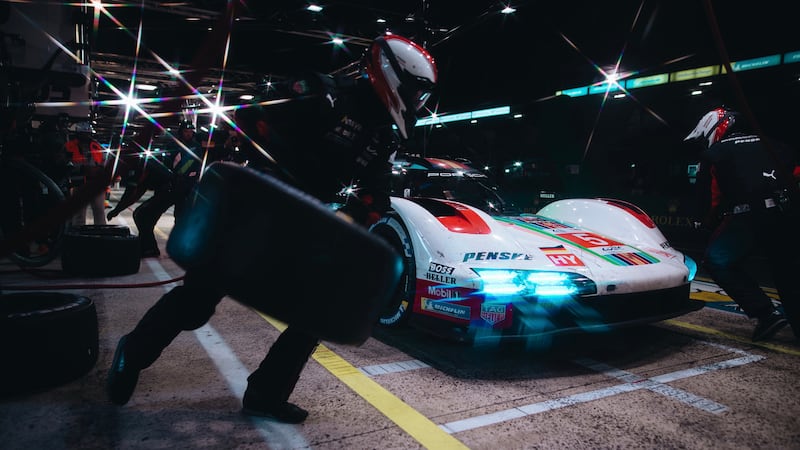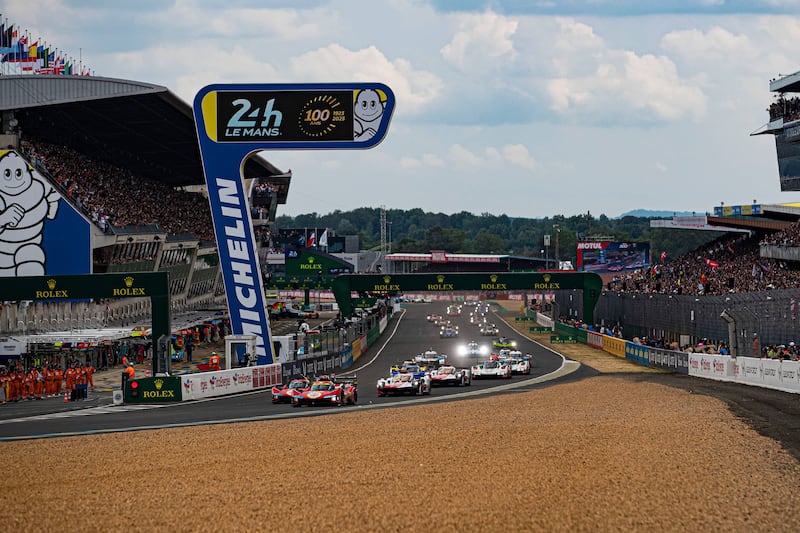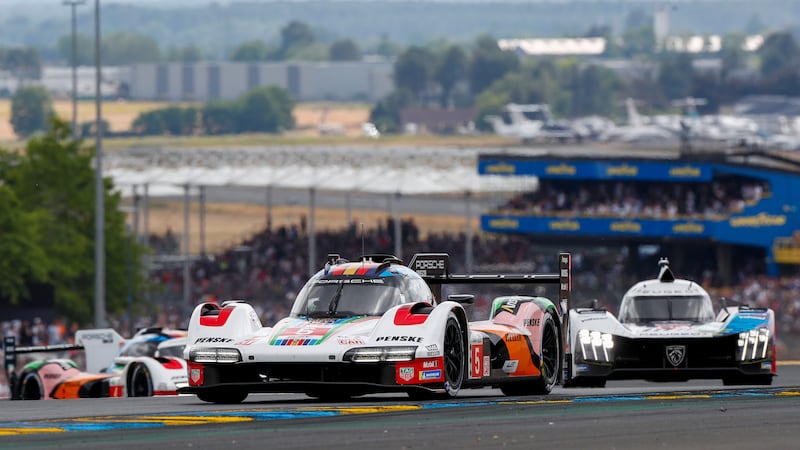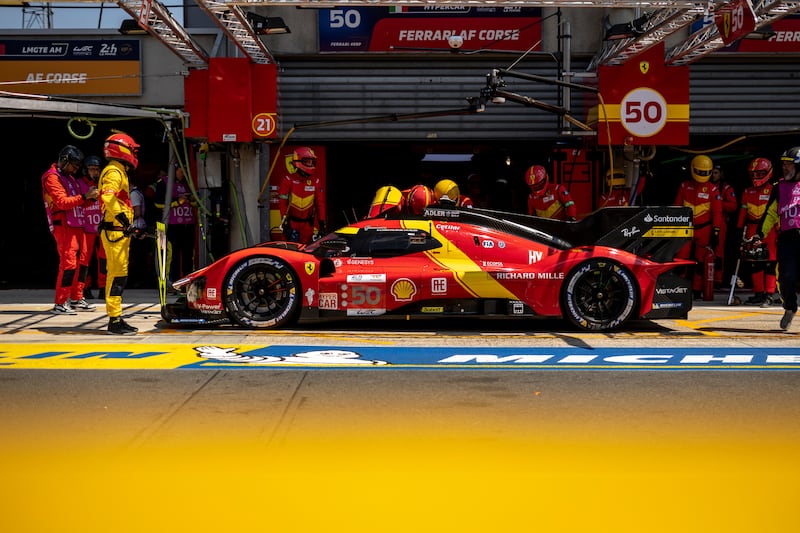In the end, it came down to a small error. Poor Rio Hirakawa, the Japanese driver who was put into the fast-moving Toyota TS010 race car with two hours of the 24 left to run. His instructions were essentially win or bust — give it all to chase down the leading Ferrari, just tantalisingly within reach after all-but a full day of racing.
Sadly for Hirakawa, and for Toyota’s hopes of defending its Le Mans crown, a small mis-step put Hirakawa into a gravel trap — only for a few moments, but those were critical moments in a race that looked set to be decided by the finest of margins.
The previous afternoon, the 24hrs of Le Mans had started in incredible fashion. In recent years, we’ve been used to Toyota effectively racing itself and the conditions, with only intermittent competition from the likes of the privately-entered Glickenhaus team, owned and funded by American film producer Jim Glickenhaus.
For 2023 though, it was all-change. This was the 100th anniversary (albeit not the 100th running of the race, actually the 91st) of Le Mans and everyone wanted a slice of the centenary glory.
Zach Bryan at Phoenix Park: Stage times, set list, how to get there and more
The Lions are in a no-lose position against Argentina, provided they don’t actually lose
Henry Mount Charles obituary: Affable, striking figure who brought rock music to Slane
Olympians give a splash course in the art of high-speed sailing
Peugeot returned, running a stunning-looking 9X8 and looking to repeat its winning ways of the early nineties and 2009. Porsche, the most successful name in Le Mans history with 19 wins, also returned, with a four-car effort divided between the famed American Penske racing squad and a privately-entered car from Britain’s Jota Sport.
Cadillac — which has surprised everyone with its pace in recent races in Europe and the US — also showed up, with a three-car squad of cars powered by spectacularly noisy 5.0-litre V8 hybrid engines.
Most significantly of all, though, Ferrari came back. While the greatest name in motor sports has had numerous victories in the second-string GTE category at Le Mans — which uses road-car-based racers — in the past two decades, this year is the first since 1973 that Ferrari has been at Le Mans in the top category, directly facing down Toyota and Porsche.
With a pair of exceptionally-fast 499P cars, which uses a V6 hybrid engine similar in concept to that used by the 296 GTB road car, the red cars were not only quick, but were backed up by experience — the entry being handled by the AF Corse team, which has scored all those GT class wins for Ferrari.
Right from the off, there was chaos. One of the Cadillacs speared off into the barriers in the first couple of laps, triggering a long period behind the safety car. Once free of that encumbrance, Toyota, Porsche, and Ferrari started going at it hammer and tongs. The Ferraris arguably had the edge on straight-line speed, the other two pulling it back through the corners.

As these top-spec cars traded laptimes and almost traded door handles, so close was the racing, utter bedlam broke out as cars from both the GT and the less-fast LMP2 category began spearing off the road and spreading gravel and debris back onto the track. And that was in the dry — when a couple of sudden, heavy rain showers arrived things became even more chaotic and it soon seemed that no team out there was immune a trip into the gravel trap.
As this back-and-forth began to shake out, it was the gorgeous gold-coloured, Hertz-sponsored Jota Porsche that held the lead and seemed to be driving away from its opposition. Sadly, a slip through the ultra-fast Porsche Curves that end the 13km lap put the Jota car hard into the barriers, tearing off bodywork. Impressively, the Jota team managed to repair the car within four laps, but by then any hope of a win had gone.
Now it was down to the works Porsche Penske team to take up the mantle of Ferrari fighter and Porsche torturer, but a series of reliability issues and driver errors blunted the effort, and a couple of penalty points for pitstop errors didn’t help.
So it devolved into a straight fight between Toyota and Ferrari? Not quite, for there was another twist. Those Peugeots might have been gorgeous, but in the lead-up to the race, and in the early laps, they just hadn’t looked fast enough. When the rain hit, however, the Peugeot came to life and by 11pm the No.94 car actually found itself in the lead.
When the fastest Ferrari tripped up and had its own brief trip to the gravel at the first chicane on the famed Mulsanne Straight, the Peugeot suddenly found itself with a lead of more than a minute. Sadly, that lead was almost immediately wiped out by a period of running behind the safety car, as accident debris was cleared up, and later reliability problems put the valiant Peugeots further back.

Further down the grid, we saw the last runnings of both the LMP2 category — purpose-built racing cars, but less expensive to build and run than the top-class Hypercars — and the GTE category, which is going to be replaced next year by a GT3 category which is even closer to being road-legal.
In some ways, that’s a good thing not least as the move to GT3 will open up the category to more car makers. Ford has already confirmed that it will make a GT3 version of the Mustang coupe available to the private teams which will make up the category. Will we also see the likes of Mercedes, Bentley, Audi, McLaren and other who make GT3-spec cars joining in? Hopefully so.
For all that optimism, there are those who decry the move away from GTE-spec cars, not least Charlie Eastwood. The Belfast driver had a terrific race, battling to bring a crash-repaired Aston Martin Vantage home in second. “I’m absolutely gutted,” he told Autosport magazine about the demise of GTE. “I drive round here and I know GT3 will just never feel the same. For me, ABS [anti-lock braking, banned in GTE but allowed in GT3 - Ed] takes out 80 per cent of the driving for the driver and what made qualifying so difficult was going from the highest speeds the GTE can go to right down to the lowest at the chicanes. You’re on the verge of missing the corner and that’s the bit that, when you then get to the line, it’s so satisfying. I have no doubt the racing is still going to be incredible with GT3, but I absolutely love the GTE.”
Sadly, other Irish interest in the GTE category came to an end early on Sunday morning when the No.911 Porsche — driven by Hollywood legend Michael Fassbender — smacked the barriers hard enough that the car could not be repaired. It was a sad end to a strong performance by the car, in which Fassbender proved that he’s no film-star dilettante behind the wheel.
The winner of the last GTE race at Le Mans was Corvette, which bet all on a single car and won against a gaggle of Porsches, Ferraris, and Aston Martins. Actually, it was a bit of a popular weekend for General Motors — the US car making giant was represented by Corvette in GTE, Cadillac in Hypercar — which scored an impressive third place on the brand’s first return to Le Mans since the 1990s — and by a single Camaro coupe in the ‘Garage 56′ slot reserved for one-off innovative cars.
This big, blue coupe was actually a much-modified NASCAR racer, and driven by three legendary drivers — Jimmy Johnson, many times a NASCAR champion; Jenson Button, the 2009 F1 world champion; and Mike Rockenfeller, a former Le Mans winner with Audi. Rumbling around, propelled by the soundtrack of its big V8 engine (running, like all the cars here, on renewable carbon-neutral fuel provided by Total Energies) the Camaro quickly became a fan favourite.

Running in a class of one, the Camaro didn’t really have anyone to race against, but up front Toyota and Ferrari had now left the rest behind, and were setting out to decide who would be the greatest — the biggest car maker in the world, or the most famous?
Sadly, instead of a wheel-to-wheel fight to the last lap, Hirakawa’s tiny error dropped the Toyota back far enough that it was no longer a threat, and the Ferrari of Alessandro Pier Guidi, James Calado, and Antonio Giovanazzi triumphed — 50 years since the last time Ferrari entered the top category at Le Mans, and as winners for the first time since 1965, drivers from a red car stood atop the Le Mans podium.

At the last second, it seemed as if there were a final Joker card to play when the red car failed to re-start its engine after its final pitstop. Hopes soared across Tokyo and pulses raced in Maranello as Pier Guidi had to effectively ctrl-alt-del the Ferrari’s electronic system, but at last — and before Toyota could make good its own delay — the engine stuttered, wheezed… and fired and the Ferrari was back in the race and still in front.
Toyota won’t be happy with second place — indeed Toyota’s president, Akio Toyoda, was vocal in the lead-up to the race that tweaks to the rules to ensure a level playing field were actually overly-detrimental to his team. Enough of a slap in the face for Toyota to pull its Le Mans racing plug?
That seems doubtful — having won against minimal opposition in recent years, Toyota and Toyoda will be keen to prove their mettle against serious rivals, but next year it gets harder again.
BMW, Lamborghini, and Alpine will all be arriving on the grid in 2024. More cars should equal closer racing, and closer racing will mean that all of those little, tiny errors become ever more amplified. Le Mans Year 101 starts from here.














